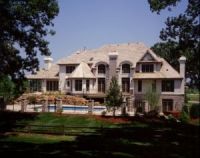As seen in The Philadelphia Inquirer:
So what’s a residential architect from Voorhees, N.J., doing in a place like this?
Gurnee is a pleasant suburban community, 35 miles north of downtown Chicago. And Scott D. Roth got to design a house here because, well, he beat out the competition.
“I don’t know how many architects were competing against me initially, but there were three on the short list,” said Roth, who maintains practices in South Jersey and outside Chicago.
This house in the Reserve at Merit Club golf-course development in Gurnee is not just any house. It is a demonstration house called Concept XI, and it is sponsored by Professional Builder magazine and the nonprofit Greater Chicagoland Housing Foundation.
One of the things Roth is demonstrating is how to build “green” – designing and building houses in such a way that resources are conserved.
For example, a builder can employ planning and design techniques that minimize disturbance to the land. It also means reducing waste during construction and throughout the life of the home.
For this project, green building means two things, Roth said. The first is the use of insulated concrete forms for the exterior walls.
“We’ve used [the] ICF system all the way to the roof,” he said. “It’s not that insulated concrete forms haven’t been used in residential construction before. It’s just that the houses made of the forms have been pretty much bland boxes, and the elevations of this house are more European.”
Roth described the elevation as “timeless,” which means that he wanted the house to look as if it had always occupied the sloping lot.
“So I guess you can say we’ve broken the mold,” he said. The 6,500-square-foot custom house was built by Buschman Homes and became the residence of company president Mark Buschman after the public viewing ended Aug. 10.
Buschman said this was the first time he or any other Chicago area builder had used ICFs to a height of two stories. The complexity of Roth’s design made the structure’s engineering critical, and when the first supplier was unable to provide the expertise, they went with a supplier that provided assurances that the walls, with just a little reinforcement, would hold.
By using ICFs, Roth achieved insulation values to R-50, with no sound or air filtration. The first floor and basement use radiant heating systems, which permit 16 heating and cooling zones throughout the house.
This is a demonstration house, and Roth acknowledges that, because of the cost, ICFs are not conducive for use in production houses.
Yet.
“The more they are used, the less they will cost,” he said.
The other major green-building feature – engineered wood studs for the interior walls and floors – is cost-effective. Using them in the floors alone reduces tree consumption by 40 percent, he said.
“The difference between this and a stick-built house is that the concrete guy and the framer are on the site at the same time,” Roth said.
“Usually, the foundation is poured and then the framers show up. But here, the framers are bolting in the first-floor joists while the concrete guys are putting in the ICFs for the second.”
Pre-engineered trusses were used for the roof. “We kept the house open all winter, and none of the exposed wood was warped or twisted,” Roth said.
The Concept XI house was designed for the well-heeled empty nester, including buyers nearing retirement with older children. Early in the design process, there was a decision not to include a formal living room.
“It is a trend in residential construction, but you don’t see it as often in the Middle Atlantic [region] as you do elsewhere because [there] the formal living room is so entwined with tradition,” he said. But in the Midwest, especially in this house, the space accorded the living room was used for the great room, the kitchen, the formal dining room, and the home office, Roth said.
While including a home office as an acknowledgement of the amount of work taken home these days, his layout kept the office far from the master bedroom, which should be an escape from the daily grind.
For those who truly need a break, there is a complete workshop near the garage on the first floor, as well as a lower level devoted to leisure activities – the “clubhouse” as Roth put it, with media room, billiard table and bar, as well as access to the swimming pool.
Roth has been working in the Chicago area for the last few years. The South Jersey architectural firm for which he previously worked, Feinberg & Associates, had briefly expanded to Chicago, but when the firm pulled back, Roth decided to keep an office there. South Jersey and the Chicago area are very different markets.
“New Jersey has a uniform construction code that every municipality must adhere to,” Roth said. “Here, anything goes, with each village coming up with its own code.”
Unlike those in the Mid-Atlantic region, Midwestern clients want constant contact with their architects, he said.
“If I design a house for a builder in South Jersey, the builder’s staff handles relations with the buyer, and I never see them,” Roth said. “Here, clients want the architect to accompany them on repeated visits to the site, from the start of planning to the completion of construction.”
Home buyers in the Chicago area care less about “maintenance-free” houses than their Eastern counterparts do, he said.
“They look down on vinyl, preferring natural materials and details that require maintenance,” Roth said. “They pay attention to everything. Even if they do use vinyl on a production house, the fascia is made of cedar.”
Home design tends to be more modern than in the East, he said, reflecting the influence of regions that feed into Chicago, such as the South and California.
“I’ve been successful in introducing modified versions of the Federal and Colonial designs common in Philadelphia,” he said. “I’ve also introduced elevations in my designs that break up the lot a bit differently than those typical in this area.”
Roth has been doing a lot of tear-downs, especially of 1950s and 1960s ranchers in Chicago’s nearer suburbs such as Highland Park and Glencoe on the North Shore of Lake Michigan.
Buildable land on the North Shore is almost nonexistent, and demand – the attraction is the New Trier School District, considered the best in Illinois – is overwhelming.
Roth works for Mayfair Development, which buys old 1,100- to 1,700-square-foot properties for $325,000 and sells the new 2,700- to 3,400-square-foot homes for $500,000 to $900,000.
One-third of the new houses are under contract before they are built.


